
Water Mark and its origin
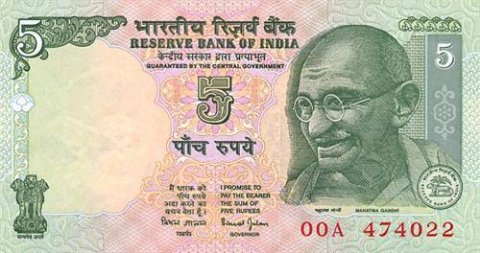

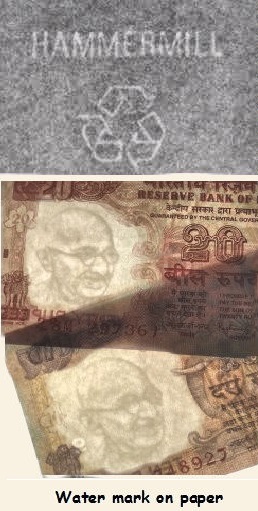
The embedding of Water mark on paper is considered to be one of the strongest security features to protect the documents from being easily counterfeited or forged. Embedding of Water mark on paper was initially adapted to identify the paper and the sizes and thickness in which they were manufactured by the specific mills. Now they have come handy for use on important security documents to protect those from being counterfeited and the concept has not been disputed over 1000 years even as it has been invented.
The origin of Water marking the sheets traces back to Italy which reportedly adapted the concept of embedding Watermarks on paper sometime in 12th century. According to the historians the first known oldest Water mark paper has been manufactured in the year 1284 in Italy. Some researchers claim the period to be 1289 though everyone is unanimous that the origin has been from Italian paper mill. Perhaps this concept (Water marking) may have been adapted by the paper mills in Italy to identify the paper manufactured by them, something like a registered trade mark to protect their product being misused. The Water marking concept was held secret and not made known to the outer world till 14th century after which it began to slowly spread to other countries via Europe.
What is Water Mark? The Watermark is an image or pattern or text embedded on the surface of the paper either as mono tonal or multi tonal image and they remain translucent but visible and identifiable when viewed against transmitted light. The multi tonal Water mark on paper is considered to be an important security feature.
It is stated that the first set of Water mark resembled somewhat to that of a Cross with few circles. Later set of Water marks were reportedly in the shapes of lines, circles, triangles, knots etc followed by images of human figures, flowers, fruits, animals and other creatures. They were numerous simple drawings adapted as Water mark designs and subsequently developed into mono tonal image i.e varying shades of light and dark, then as multi tonal images where the images graduated from lighter to dark to deep darker areas like graduating grey scale image. Now this has further developed into Water marking with three dimensional images, Pixel images and so on. See below illustrations of some of the Water marks used in earlier era.
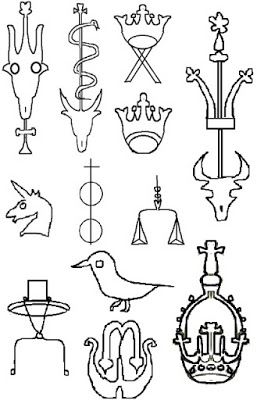
There are references in one of the books titled “Early Venetian Printing” written by Carlo Castellani which mentions:
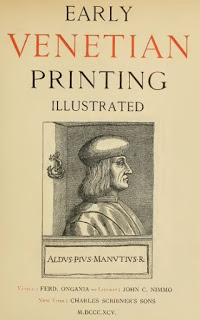
Quote:-
….. that the papers with embedded water mark have been used in Italy somewhere at the end of 14th century. Everything conduces to the belief that the Venetian printers brought the paper for their books chiefly from the paper mills of Padua or of Treviso. The watermark which is most frequently observed in Venetian books is the balance in its many variations of form both in the scales and in the supports. The bull’s head also, with various convolutions of the horns, and with great variety in the figures which are placed between the horns, often occurs. Then too there is the figure of the hat with various interlacing of the cords. Besides these watermarks the book sprinted at Venice show from time to time other figures, such as the imperial crown and the royal crowns, the glove, scissors, ladder, ‘standard, shield of arms, castle, crescent, crossbow, strung bow with its arrow, crosses, crossed swords; and the cross; and then, the horse, the bull and other animals. Now all these signs as water-marks are peculiar to the mills of Padua and Treviso. This circumstance added to the fact of the close relations and easy communication between Venice and those cities strengthen the supposition that the Venetian printers brought the paper for their books chiefly from those mills……..
:-Unquote
The following text as found in the site of ‘Confederation of Paper industries’ (http://www.paper.org.uk/information/pages/glossary.html) mentions :-
Quote:
………. Designs impressed into paper while in course of manufacture by means of a projecting wire, on the mould, or in the case of machine made qualities on the dandy roll. Watermarks were employed as early as 1282. They served to identify the product of each paper mill and the designs chosen (many of them extremely complicated) also expressed emblematically the tenets of the manufacturers, which were handed down traditionally from father to son. It was customary, and the custom has survived until the present day, for paper mills to use similar designs in common. These standard designs were triflingly modified by each individual maker; they have in many cases been the origin of modem terminology, such as Foolscap, Pott, Post and so forth……………
:Unquote
The first group of paper Water marked paper made were Azure Laid paper used by financial institutions and Legal fraternity and Cream wove paper used for many other purposes. Laid (Azure laid) paper contained an overall pattern of thin translucent lines or bars laid in columns or paras and the Wove paper contained an overall translucent pattern that resembles woven cloth. This is how those papers got their names.
In nutshell it is reasonable to think that the basic intention of the process of Water marking of the paper may have began for : Identifying the products manufactured by the mills Identify the sizes and thickness in which the papers used may have been manufactured Protect the products from misuse by others to sell the product under their stamping Establish brand quality in the midst of competition Deter forgeries of those important documents, especially those covered by legal aspects. On the broader side the Water mark designs have helped the Researchers in their study in identifying the date and period of texts on paper and the place where they may have been printed while culling historical information since in the earlier era each of the Water marks represented particular mills and also carried the year of manufacture of the papers as each year the mills changed their Water mark designs.
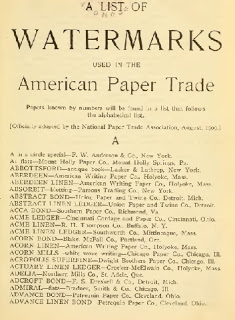
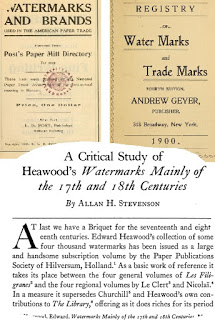
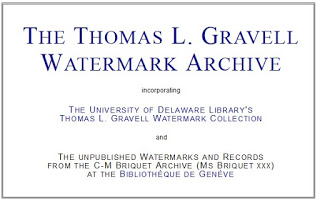
There has been hundreds and thousands of Water mark designs as found to have been used by different mills and vast study has been internationally conducted on the use and importance of Water Marks. Over 16000 Water marks have been reportedly identified by one of the French researcher. An American Paper Trade reference book, 1909, officially adapted by National Paper Trade Association, has listed over 4000 Water marks used by several suppliers in America. In the year 1997 an association named IPH (International Association of Paper Historians) compiled a Water mark Registry consisting of several watermarks and grouped them broadly under seven categories such as Line, Shadow, Shadow combined with Line and Molette. They have been able to list out over 16000 Water marks of several types after researching several books printed in Low countries prior to 1501.

- Line -(plain dark sketch) Water mark which was plain wire mark formed by the sewn image with metallic wire.
- Shadow Water mark – light and shade effect which again is made of metallic wire but giving a shadow effect by the side of the plain line work. This could have been achieved by slightly lowering the height of shadow portion wires below the actual image thus lessening the pressure given on the paper to leave freak image.
- Combined Line / Shadow -too has the Water mark images built in combination as above.
- Embossed -or Tonal marks that has images impressed on the sewn wire. The depth of tonal effects may have been given by the gradual decrease in depth (height) of surface that touched the paper to produce the tonal effect Water mark.
- Molette – in a way is similar to embossed or impressed marks, but has more lighter and deeper shades.
A very interesting article on Water mark has appeared in Theosophy, Vol. 53, No. 9, July, 1965 (Pages 262-266; Size: 14K) under the heading Heretics and the renaissance: Part VI –‘The Albigensian paper makers and water marks’ and VII- ‘A new light on the renaissance’.
The information contained in it is worth reading which is reproduced below :
Quote:-
Part VI – The Albigensian paper makers and water marks
………..Watermarks, still commonly used at the present time, originated with the Albigensian paper makers of Southern France and Northern Italy. A study of the various watermarks has yielded some results in tracing the different channels in which the paper trade of different countries flowed. Experience also of the different kinds of paper and a knowledge of the watermarks, aid the student in fixing nearly exact periods of undated documents. (Britannica, 9th ed.) …………….
…………..The first paper marks or watermarks appeared in Italy about the year 1270, and while these originals were artless in design, the emblems were so mystic in character that it is reasonable to believe that they were meant to convey a meaning or signal among the workers who fashioned them. It has been suggested that these old devices may have been used solely as marks of identification for sizes of moulds and the paper formed thereon, or, as they are used today, simply as trademarks of the paper makers. Other writers have advanced the theory that they may have been employed in a purely symbolic sense, as Mr. Harold Bayley sets forth in his books dealing with the semeiotic significance of the old paper makers‘ and printers’ marks and emblems. According to Mr. Bayley, the watermarks of the Middle Ages were employed by the heretical paper makers as symbols of religious propaganda. Mr. Bayley attaches symbolic importance to each of the old watermarks and believes that these fantastic emblems embodied a hidden meaning understood only by the people of medieval times. This explanation of their use seems more probable than to try to account for the myriad watermark designs as symbols for the identification of paper sizes, or as trademarks of the makers of paper. (p. 26.)………………..
VII- A new light on the renaissance
…………….. The twelve chapters of Mr. Bayley’s book, containing over 400 reproductions of watermarks, are headed as follows: “Paper making and The Albigenses,” “Religious Emblems,” “Emblems of The Deity,” “Emblems of Persecution and Preaching,” “Romaunt Emblems,” “The Philosopher’s Gold,” “The Kabbalah,” “The Inventing of Printing,” “Printers’ Devices,” “The Transference of Woodblocks,” “Tricks of Obscurity” and “The Renaissance.” These are followed by a “Conclusion” covering eighteen pages, and 29 pages of “Notes and References” constituting an extensive bibliography, not only on the subject of watermarks, but also on Symbolism, Heresies, Secret Societies, Inquisition, Reformation, Renaissance, and many more, including several references to H. P. Blavatsky……………………..
:- Unquote
Water mark remains both as visible and invisible image. The modern era Watermark is an important security feature on paper used for printing the Postal stamps, Currencies or Bank notes, and other important government financial instruments to deter counterfeiting. It is stated that though the first set of Water Mark papers have been manufactured in the 13th century in Europe, specially in that of Italy where the first group of paper mills have been reportedly set up in early 12th century, the first set of handmade mould Water mark paper for use on Currencies has been reportedly introduced in the year 1725 in England when in 17th and 18th centuries many paper mills across England began to practice use of certain Water mark symbols on the papers manufactured by them.
The visible Water mark may appear as some kind of a weak print merged with the shade of the paper in which they may have been embedded. The lighter and darker shades of the Watermark are caused by the lesser and more pressure of the Water mark mould leading to that much proportional deposit of fiber in those areas embedded.
The invisible Watermark which is also translucent image or pattern embedded in similar fashion as above, but with some design elements over printed in those areas to hide the Water mark. The examples could be Water mark on Bank Notes and Currencies, Postal stamps, paper used for printing ID cards etc wherein certain image of the Water mark remains visible to naked eye in non printed area while part of the Water mark remain hidden under the designs printed.
How is the Water mark formed ? The oldest form of watermarks is referred to as wire watermarks since they were generated by bending pieces of wire into required designs by tying them onto the mesh of the paper moulds which was then impressed over the semi wet paper travelling on wire mesh. The darker and lighter shades of the Water mark image is represented in the form of raised and depressed areas on the fine-mesh brass-wire fabric attached to the dandy roll’s circumference to generate the Water mark during paper making process. The formation of the image on the wire mesh is ticklish and cumbersome process even involving certain amount of hand engraving technique to form lighter and darker shades. The Water marks produced by the images carved out on the fine-mesh brass-wire fabric will not be as clear and sharper as produced in cylinder mould process. One of the reasons for the slightly imperfect Water mark generated by the Dandy roller process could be due to tying of the mould screen with wires which will have feeble dots even after welding them, hence the edges leave unsharp images. Therefore the modern mills began the use of Water mark engraved cylinder (mould) which was able to produce much cleaner images with high tonal values unlike the rugged Water mark images produced by the Dandy roller.
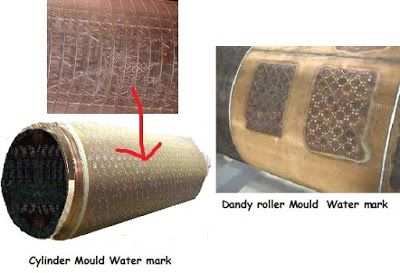
The Water mark is formed by two different processes. One is called the Dandy roll process, and the other is Cylinder mould process. Even today many mills around the world continue to use the Dandy roll process for Water marking because they are cheaper and meet the purposes of protecting and identifying their products. However the Cylinder mould process is preferred mainly by those who are engaged in the art of printing high value security documents of several nature including Currencies and Bank Notes as Water mark is an important security feature as suggested and admitted by the International Intelligent agencies such as Interpol.
During paper manufacturing process, the wet pulp filled with fibers is spread over a long wire mesh which travel on the wire mesh in the form of a sheet and shed the excess water from their body through the wire mesh before getting dried further travelling through several series of rollers. When the semi wet paper travel on wire mesh screen the Dandy roller fastened with Water mark design from above press the semi wet layer of paper against the wire mesh like rubber stamping process and wherever they press, the fibers on those areas gets thinner and compressed according to the degree of relief on the areas of the image. This process forms the image over the thin layer of semi wet paper which when dried will show the Water mark in the form of an translucent image. However during the stamping process the Dandy roller does not completely remove the fibers from those image areas, lest the paper will have only holes in those areas pressed. During the process of pressing, the fibers get deposited in different densities and vary the thickness of the paper in those areas pressed to show the images of varying shade. The thick and thin deposit of fibers shows the multi tone Watermark effect.
Initially a flat surfaced Dandy was used. However as the Mills began to produce continuous reels of paper the cylindrical Dandy roller was put to use for rotating against the travelling layer of semi wet paper and to impress the images at regular intervals as preset.
Though the researchers claim that the invention of the so-called, Dandy roller is actually attributable to one John Marshall, of T.J. Marshall (name of the firm) of London, who established his own mill in the year 1792, he reportedly failed to apply for the patent and therefore the patent had been taken over by some other people in Europe itself – one for the process of leaving an Watermark impression by cylindrical body and other for the invention of Dandy roller.
The use of Cylinder mould Water marking perhaps began in the year 1848 where in instead of covering the cylinder with brass wire fabric containing the Water mark image, the cylinder body itself was prepared in a different fashion welded by a wire mesh embossed with the Watermark design reflecting tonal depth of varying shades of a grey scale.
The introduction of cylinder mould made it possible to engrave the images or patterns of different shades with much clarity. The resulting Watermark was also much clearer, sharper and more detailed than those made by the Dandy Roll process. This paved the way for the production of Cylinder Mould Watermark Paper for Currencies, Banknotes, Passports, and other Security documents of high value as the Water mark still remains an important anti-counterfeiting feature.
The light and shaded tonal effect Water mark was also produced by a process called Electrolytic process which is nothing but basically an offshoot of electroplating process. The Water mark produced on paper deploying this process for making Water mark mould was called Electrolytic Water marks and were used for many years by some countries for printing Currencies. The desired Water mark image is first carved out on a wax plate, which after treated with some chemical process enabled two image dies (plates)- male and female to be prepared by electrolytic process. A specially prepared finely sewn wire mesh was kept in between the male-female dies and pressed to get the Water mark image over the fine wire mesh. The pressed wire mesh will reflect the darker and lighter tonal values by the degree of relief on the male female dies. The tonal values represented in the form of proportional relief over the Water mark image of the wire mesh was technically called Bas relief. The wire mesh was attached on the Dandy roller for creating the Water mark images on paper.
While the paper making machine was invented in the year 1798 in place of paper made by hand made process the first automatic paper making machine that used the Dandy roller Water marking process is reported to be Fourdrinier machine in 18th century in Europe.
The Watermarks vary in visibility and appearance to some extent when different mills produce the same Water mark in view of the machineries and processes deployed by them even though the basic raw material is same and the approved drawing is given for generating the Water mark. Since there appears to be no measured values for each and every lines or shades of the Water mark produced and suitable instruments to test them, the overall resultant image could only be matched as closely as possible with that of the golden image of the Water mark proof stored in the computers to authenticate the genuineness of the Water mark image produced on the paper. This limitation is because of the inability to maintain absolutely uniform fiber length in the pulp that forms the paper and leaves thick and thin deposits to match the shades of the Water mark images.
Few well known paper mills who have expertise in the art of paper making and whose paper supplies are used by several countries for the production of Bank Notes and Currencies have come out with new series of Water marks invented by them which not only enhanced the clarity of the Water marks produced, but also makes the counterfeiting more and more difficult. The following information in this regard is available from the sites of those two well known expert paper manufacturers – Giesecke & Devrient of Germany and Arjowiggons of France both paper mills of repute around the world.
Out of two important Water marks – High Light Water mark and Pixel Water mark- Giesecke & Devrient mentions that:
Quote:
………HighLight watermarks security features are very effective for portraying the numbers or the value of a banknote denomination. When held against the light, numbers or characters appear as accentuated elements within the watermark design. HighLight watermark are created during paper making by reducing paper thickness to produce very light areas that increase the visibility of particular design elements….
…………..Pixel watermark security features offer new possibilities for developing eye-catching watermark designs that are secure against counterfeiting. The highly contrasting bright three-dimensional effect that is visible when held against the light is very easily authenticated by the public. Pixel watermarks are created during paper making by varying the thickness of the paper to produce patterns of dark pixel dots on a lighter background. Due to the complexity of their creation, Pixel watermarks are extremely difficult to counterfeit, resulting in only poor quality print copies of watermarks…………
:-Unquote
Arjowiggons, French the second paper mill site mentions that :
Quote:-
The Pixel watermark is made up of a pattern or array of dark dots on a light background that creates a three-dimensional effect and provides a high level contrast with the background……….
……… The Pixel Watermark is formed by dots of various sizes and shapes on a light background that create a unique design ……… .
……… The high-contrast background provided by the Pixel Watermark enhances the visibility of the multi-tone Watermark ……….
………… The remarkable brightness of the Pixel watermark and the high level of detail and contrast are very difficult to reproduce …………
………….. The Vision watermark, our latest development in watermark technology, offers higher definition and better image recognition. In accordance with the trend in banknote design for more realism, the Vision watermark carries more detail than the traditional multi-tone watermark, getting closer to the original image. It can be combined with the multi-tone, Pixel and electrotype watermarks for enhanced banknote protection ………….
:-Unquote
Originally the Water mark image was embedded on paper as security feature during paper marking process using dandy rolls or engraved metal blocks and the extent of clarity and shades were improved by changing the thickness of the paper. However as the technology improved the digital Water marking feature came to be adapted to protect the printed images.








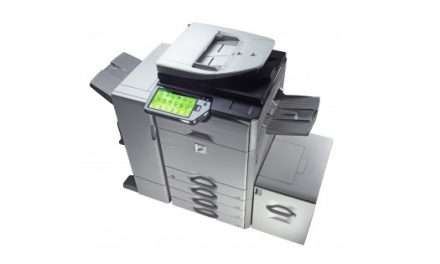





Recent Comments